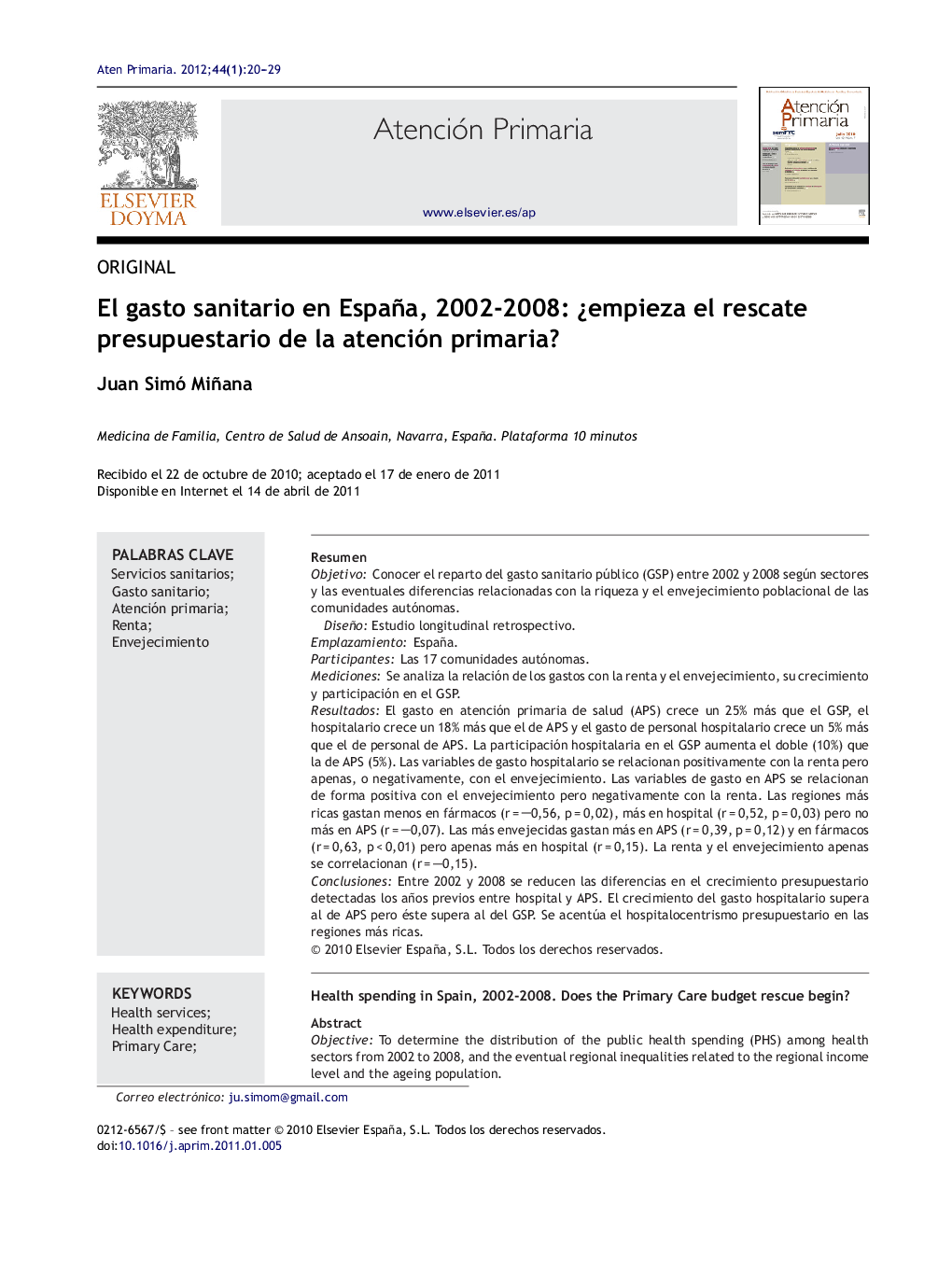| کد مقاله | کد نشریه | سال انتشار | مقاله انگلیسی | نسخه تمام متن |
|---|---|---|---|---|
| 3458540 | 1230979 | 2012 | 10 صفحه PDF | دانلود رایگان |

ResumenObjetivoConocer el reparto del gasto sanitario público (GSP) entre 2002 y 2008 según sectores y las eventuales diferencias relacionadas con la riqueza y el envejecimiento poblacional de las comunidades autónomas.Diseño: Estudio longitudinal retrospectivo.EmplazamientoEspaña.ParticipantesLas 17 comunidades autónomas.MedicionesSe analiza la relación de los gastos con la renta y el envejecimiento, su crecimiento y participación en el GSP.ResultadosEl gasto en atención primaria de salud (APS) crece un 25% más que el GSP, el hospitalario crece un 18% más que el de APS y el gasto de personal hospitalario crece un 5% más que el de personal de APS. La participación hospitalaria en el GSP aumenta el doble (10%) que la de APS (5%). Las variables de gasto hospitalario se relacionan positivamente con la renta pero apenas, o negativamente, con el envejecimiento. Las variables de gasto en APS se relacionan de forma positiva con el envejecimiento pero negativamente con la renta. Las regiones más ricas gastan menos en fármacos (r = 0,56, p = 0,02), más en hospital (r = 0,52, p = 0,03) pero no más en APS (r = 0,07). Las más envejecidas gastan más en APS (r = 0,39, p = 0,12) y en fármacos (r = 0,63, p < 0,01) pero apenas más en hospital (r = 0,15). La renta y el envejecimiento apenas se correlacionan (r = 0,15).ConclusionesEntre 2002 y 2008 se reducen las diferencias en el crecimiento presupuestario detectadas los años previos entre hospital y APS. El crecimiento del gasto hospitalario supera al de APS pero éste supera al del GSP. Se acentúa el hospitalocentrismo presupuestario en las regiones más ricas.
ObjectiveTo determine the distribution of the public health spending (PHS) among health sectors from 2002 to 2008, and the eventual regional inequalities related to the regional income level and the ageing population.DesignA longitudinal and retrospective study.SettingSpain.ParticipantsThe 17 Autonomous Communities.MethodsThe relationship between health expenditure and income and ageing population in the regions, their growth and participation in PHS was analysed.ResultsPrimary Care (PC) expenditure has increased 25% more than the PHS; hospital spending has grown 18% more than the PC and hospital staff spending has grown 5% more than the PC staff. Hospital participation in PHS is twice (10%) that of PC participation (5%). Hospital expenditure variables were positively correlated with income but barely, or negatively, with ageing population. PC expenditure variables were positively correlated with ageing but negative with income. The richest regions spend less on drugs (r = 0.56, p = 0.02), more on hospitals (r = 0.52, p = 0.03) but not more on PC (r = 0.07). Regions with more ageing populations spend more on PC (r = 0.39, P = .12) and drugs (r = 0.63, P < .01) but just more on hospitals (r = 0.15). The income level barely correlates with ageing population (r = 0.15).ConclusionsBetween 2002 and 2008 the differences detected during the previous years in the budget growth between hospitals and PC were reduced. The growth of spending on hospitals is higher than on PC, but this is higher than PHS. The centralising of care in hospitals is notable in the richest regions.
Journal: Atención Primaria - Volume 44, Issue 1, January 2012, Pages 20–29